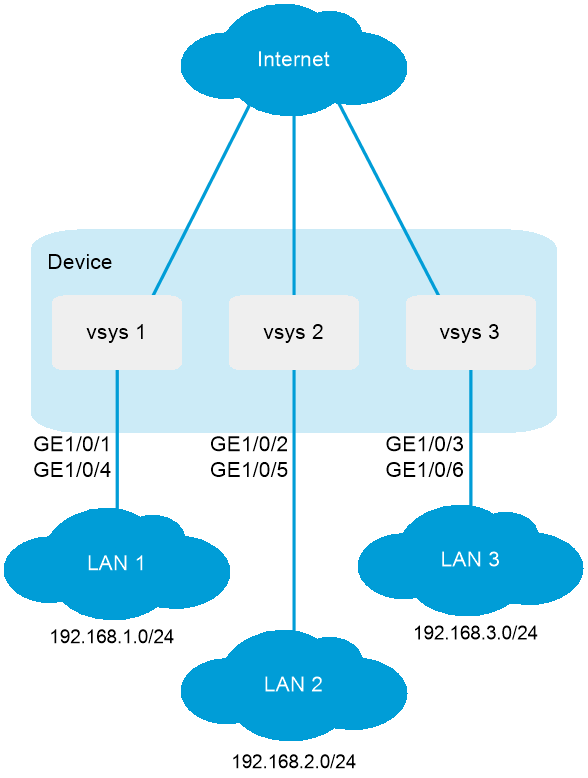
As shown in Figure 1, LAN 1, LAN 2, and LAN 3 use 192.168.1.0/24, 192.168.2.0/24, and 192.168.3.0/24, respectively.
Configure vSystems for the LANs as follows:
Configure vSystem vsys1 for LAN 1.
Configure vSystem vsys2 for LAN 2.
Configure vSystem vsys3 for LAN 3.
This configuration example was created and verified on F9900 of the F5000-AI120 device.
1. Configure vSystem vsys1 for LAN 1:
# Create a vSystem named vsys1 and configure a description for it.
<Device> system-view
[Device] vsys vsys1
[Device-vsys-2-vsys1] description vsys-1
# Assign GigabitEthernet 1/0/1 and GigabitEthernet 1/0/4 to the vSystem.
[Device-vsys-2-vsys1] allocate interface gigabitethernet 1/0/1
Some configurations on the interface are removed.
[Device-vsys-2-vsys1] allocate interface gigabitethernet 1/0/4
Some configurations on the interface are removed.
[Device-vsys-2-vsys1] quit
# Log in to the vSystem from the default vSystem.
[Device] switchto vsys vsys1
<Device-vsys1> system-view
# Configure Telnet login to enable remote vSystem management. (Details not shown. For more information about Telnet login configuration, see login management in Fundamentals Configuration Guide.)
# Assign IP address 192.168.1.251/24 to GigabitEthernet 1/0/1.
[Device-vsys1] interface gigabitethernet 1/0/1
[Device-vsys1-GigabitEthernet1/0/1] ip address 192.168.1.251 24
# Return to the default vSystem.
[Device-vsys1-GigabitEthernet1/0/1] return
<Device-vsys1> quit
[Device]
2. Configure vSystem vsys2 for LAN 2:
# Create a vSystem named vsys2 and configure a description for it.
[Device] vsys vsys2
[Device-vsys-3-vsys2] description vsys-2
# Assign GigabitEthernet 1/0/2 and GigabitEthernet 1/0/5 to the vSystem.
[Device-vsys-3-vsys2] allocate interface gigabitethernet 1/0/2
Some configurations on the interface are removed.
[Device-vsys-3-vsys2] allocate interface gigabitethernet 1/0/5
Some configurations on the interface are removed.
[Device-vsys-3-vsys2] quit
# Log in to the vSystem from the default vSystem.
[Device] switchto vsys vsys2
<Device-vsys2> system-view
# Configure Telnet login to enable remote vSystem management. (Details not shown. For more information about Telnet login configuration, see login management in Fundamentals Configuration Guide.)
# Assign IP address 192.168.2.251/24 to GigabitEthernet 1/0/2.
[Device-vsys2] interface gigabitethernet 1/0/2
[Device-vsys2-GigabitEthernet1/0/2] ip address 192.168.2.251 24
# Return to the default vSystem.
[Device-vsys2-GigabitEthernet1/0/2] return
<Device-vsys2> quit
[Device]
3. Configure vSystem vsys3 for LAN 3:
# Create a vSystem named vsys3 and configure a description for it.
[Device] vsys vsys3
[Device-vsys-4-vsys3] description vsys-3
# Assign GigabitEthernet 1/0/3 and GigabitEthernet 1/0/6 to the vSystem.
[Device-vsys-4-vsys3] allocate interface gigabitethernet 1/0/3
Some configurations on the interface are removed.
[Device-vsys-4-vsys3] allocate interface gigabitethernet 1/0/6
Some configurations on the interface are removed.
[Device-vsys-4-vsys3] quit
# Log in to the vSystem from the default vSystem.
[Device] switchto vsys vsys3
<Device-vsys2> system-view
# Configure Telnet login to enable remote vSystem management. (Details not shown. For more information about Telnet login configuration, see login management in Fundamentals Configuration Guide.)
# Assign IP address 192.168.3.251/24 to GigabitEthernet 1/0/3.
[Device-vsys3] interface gigabitethernet 1/0/3
[Device-vsys3-GigabitEthernet1/0/3] ip address 192.168.3.251 24
# Return to the default vSystem.
[Device-vsys3-GigabitEthernet1/0/3] return
<Device-vsys3> quit
[Device]
# Verify that the device has four vSystems and all vSystems are in active state.
[Device] display vsys
ID Name Status Description
1 Admin Active Default
2 vsys1 Active vsys-1
3 vsys2 Active vsys-2
4 vsys3 Active vsys-3
#
vsys vsys1 id 2
description vsys-1
allocate interface GigabitEthernet1/0/1
allocate interface GigabitEthernet1/0/4
#
vsys vsys2 id 3
description vsys-2
allocate interface GigabitEthernet1/0/2
allocate interface GigabitEthernet1/0/5
#
vsys vsys3 id 4
description vsys-3
allocate interface GigabitEthernet1/0/3
allocate interface GigabitEthernet1/0/6
#
interface GigabitEthernet1/0/1
ip address 192.168.1.251 255.255.255.0
#
interface GigabitEthernet1/0/2
ip address 192.168.2.251 255.255.255.0
#
interface GigabitEthernet1/0/3
ip address 192.168.3.251 255.255.255.0